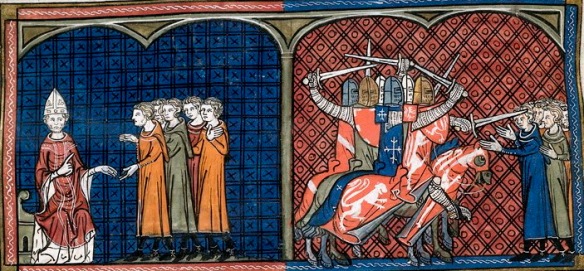The mass of the common people were poor; the bourgeoisie had already become rich, but, like the bourgeoisie everywhere, was wholly self-regarding. The nobility practised a certain ostentatious extravagance, while the prelates of the Church frequently copied the nobility, both in their luxurious habits and their addiction to warfare. The country was constantly ravaged by famine, fire, battles great and small, plague epidemics, and every sort of banditry; and yet from that same soil there arose these extraordinarily rich cathedrals. We have (if we want to reconcile these facts) to grant that men’s faith in this age possessed a special temper all its own. This frantic urge to incarnate the divine, to give it concrete shape, suggests both a deep regard for material objects and the created world, and a profound contempt for human life. The cathedrals rose on the faith of those who also offered adoration to relics.
The men of Northern France were by no means all fervent supporters of the Papacy: far from it. In 1204 the French bishops stood out against the Papal Legates when they tried to force Philip II into peace with England. The barons continually squabbled with the bishops and abbots in the furtherance of their various private interests, and the common people continually resented the tithes they were forced to pay. This does not alter the fact that, during the period under discussion, the French people as a whole were deeply Catholic, and clung to their churches, religious customs, and centres of pilgrimage as though they formed a kind of national heritage. Now the heresy that had gained ground in the districts of Languedoc was fiercely opposed in principle to all outward manifestations of ecclesiastical life; so those emissaries whom Arnald sent out to preach the Crusade had little trouble in working up the indignation of their large audiences against ‘God’s enemies’.
The stories which reappear like a faint echo in the chronicle of Pierre des Vaux de Cernay must have formed the subject of endless discussion and comment throughout the length and breadth of France ; nor, we may be certain, do they represent all the incidents that took place, or even the worst of them. One man defiled a church altar. Some soldiers in service with the Count of Foix took a certain Canon and chopped him into pieces ; they also used the arms and legs of a crucifix to grind up spices with, in lieu of a pestle. Such things must have haunted the minds of even the most casual believer.
These heretics desecrated Communion chalices and asserted that by receiving the Sacred Host one swallowed a devil; they uttered blasphemies against the Saints, declaring that they were all damned. The Pope’s words ‘they are worse than the very Saracens’ were quite literally true. Those who listened to Rome’s envoys, however, were not humanitarian by nature, and probably found the idea of a mutilated crucifix more distressing than that of chopping a man to pieces.
The King, whose mind moved along political lines, was not (so far as we can judge) extravagantly moved by the development and spread of this heresy. He showed himself, indeed, about as unenthusiastic over the proposed Crusade as he could, within the bounds of common decency. He wrote to Innocent III saying that he would not go on this Crusade unless the Pope forced the King of England to refrain from attacking France, and levied a special tax to finance the expedition. In any case he had doubts concerning the legitimacy of the scheme. In February 1209, when military detachments were gathering throughout every province, with contributions pouring in and the leaders busy preparing for the great day of departure, Innocent III wrote to King Philip:
It is to you that We especially entrust the cause of God’s Holy Church. The army of the Faithful that is forming to combat heresy must have a leader to whom its members will owe unquestioning obedience. We therefore beg your Serene Highness to choose, on your own initiative, some loyal, discreet, and vigorous gentleman who may lead the champions of Our Holy Cause to final triumph under your banner.
The King, however, refused. He would not go to the wars himself, or let his son go; he would not even accept the responsibility of choosing a deputy who could act in his name. The Pope wanted to use the King of France as a legal, secular agent of Divine Justice in this Crusade; but the Crusade remained what in sober fact it was, a war launched by the Church itself. The barons who followed the Cross would be soldiers of the Church; and the leader whom the Crusaders’ army appointed over themselves was that Papal Legate Arnald-Amalric, the Abbot of Citeaux.
The King of France was to have his turn later.
Among the barons who joined the Crusade in 1209 we know the names of Eudes II, Duke of Burgundy, Hervé IV, Count of Nevers (both already mentioned above) ; Gaucher de Chatillon, Count of Saint-Pol; Simon de Montfort; Pierre de Courtenay; Thibaud Count of Bar; Guichard de Beaujeu; Gauthier de Joigny ; Guillaume de Rocher, the Seneschal of Anjou ; Guy de Lévis, and many others. But Church dignitaries, too, figure as military leaders. The Archbishops of Rheims, Sens and Rouen, together with the Bishops of Autun, Clermont, Nevers, Bayeux, Lisieux and Chartres, all joined the Crusade. Each of them led a contingent composed half of seasoned fighters, and half of pilgrims who knew nothing of war, but were aflame with the desire to serve God’s holy Cause.
